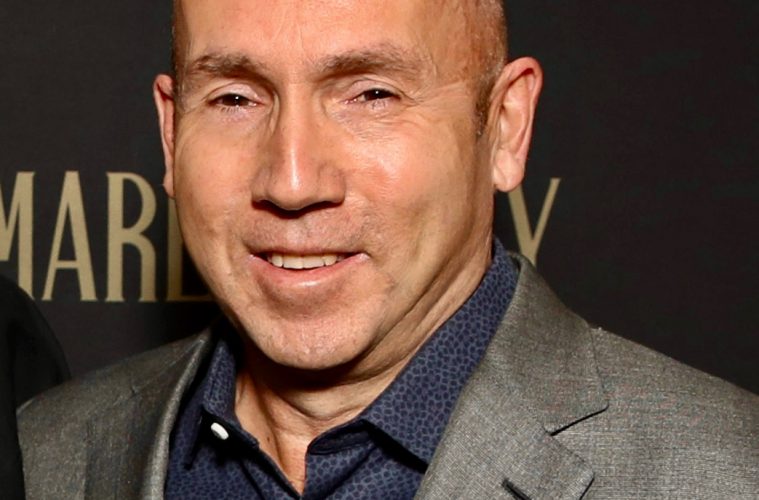Oscar winning Producer, J. Miles Dale has more than 30 years of experience in the film industry; lauded for his 2017 Best Picture, The Shape of Water, directed by award-winning filmmaker, Guillermo del Toro.
Of course, it is entirely possible that over the past few years you have seen some of his other productions in theaters or on Netflix including, Nightmare Alley (2021), Antlers (2021), Scary Stories to tell in the Dark (2019), or the tv/series Guillermo del Toro’s Cabinet of Curiosities (2022). “Miles”, as he likes to be called, has certainly been a busy man; working from his production offices in his hometown of Toronto, Ontario.
The producer’s most recent project, however, has taken a decidedly different turn from the psychologically macabre to the more family friendly fare. After finding inspiration in The Original Immersive Van Gogh Exhibit (2021), Miles approached Disney to lead a creative team in the production of Disney Animation: Immersive Experience, running now through May 14 in select cities.
Two weeks before its opening, Miles was kind enough to not only discuss his collaboration with Disney Immersive but to share some thoughts on his work as one of the more prolific, creative Producers working today in film and television.
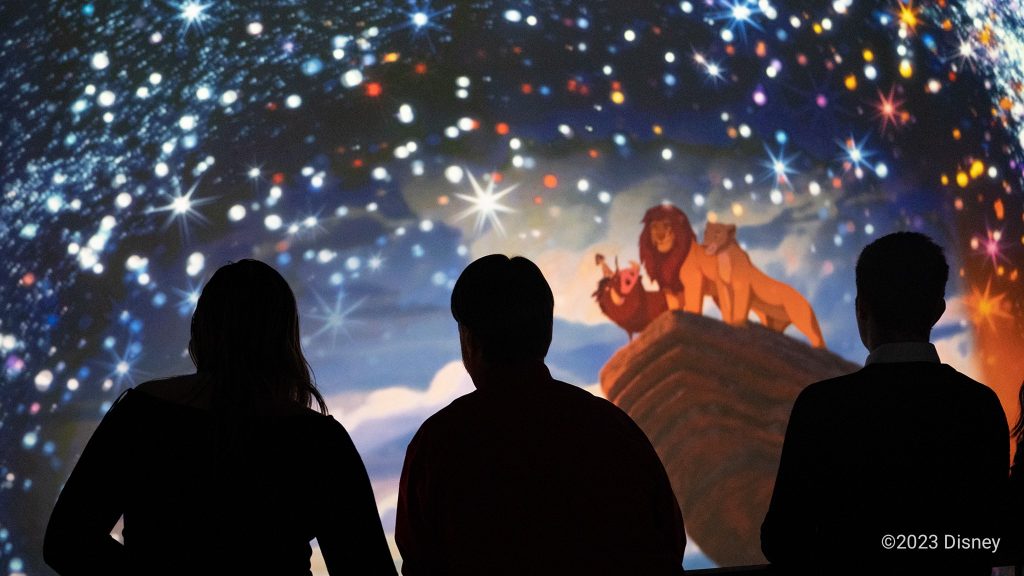
Disney Animation: Immersive Experience | photo courtesy Lighthouse-Immersive
“Putting together the right team, understanding the vision, and then supporting that vision.”
Anthony Brancaleone: Good morning, Miles.
J. Miles Dale: Good morning. How are things in Detroit?
AB: Not bad. It’s a little cold. But, we don’t seem to have much snow.
Miles: We don’t have much here either. I think we do in the north region. The Northern Lakes above Toronto. It’s beautiful land. Similar to the upper peninsula of Michigan, I am told.
AB: Have you been to Detroit?
Miles: My first ballgame with my dad was at Tiger Stadium. He took me into the Red Sox dressing room. I’ll never forget it or that stadium. It was great experience. Mostly baseball games, when I was young, or the Fox Theatre, which is beautiful.
AB: I understand you live and work in Toronto. What can you tell us about your city? Where do we go for a good meal?
Miles: My mother is Italian so the best place to go for food was always her kitchen. Toronto is filled with Italians – 4th largest Italian population outside of Italy. So, we have a few Italian restaurants that we go to. I don’t know if you know this, but Toronto is a city of neighborhoods; very multicultural – Jamaican, Middle Eastern – and each group populates around the city, creating their own areas; kind of a mosaic rather than a melting pot. Each are encouraged to keep their culture. That’s what I like most about this city. We have a great mish mash of Middle Eastern restaurants, with some of the best schwarma. So, I guess we do that on a more regular basis. For special occasions, we go to Opus or 7 Numbers; which, is something we recently discovered.
AB: I have to assume some of those celebrations are over your recent productions. Miles, you’ve been in the film business for decades, with over 35 credits as a Producer, alone. Can you share with us what makes a great Producer?
Miles: It depends on so many things but I think you’re at the center of the wheel, gathering good material, people, like a chemist where you have all the ingredients and must match personalities. A lot revolves around the script and the director, and that you can not only support the vision but be there as a second opinion. The steering of the ship is in the hands of the director but sometimes you have to steer course corrections. For me, it’s really roaming the perimeter and keep bad things away; let the director and artists do their thing. Putting together the right team, understanding the vision, and then supporting the vision, so that the team can confidently share the vision and execute.
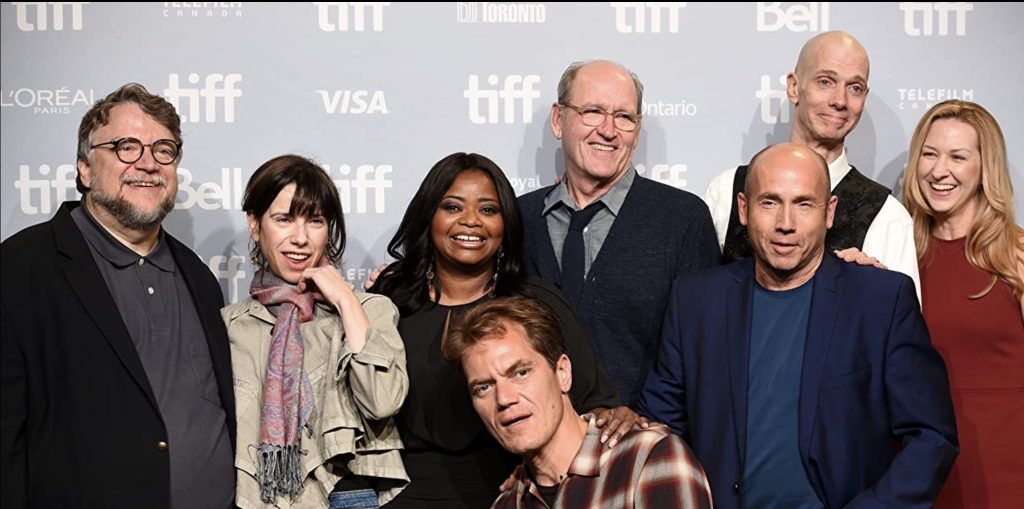
Guillermo del Toro, Sally Hawkins, Octavia Spencer, Michael Shannon, Richard Jenkins, J. Miles Dale, Doug Jones, and Vanessa Taylor for The Shape of Water (2017)
“We really had a positive, creative, environment; a happy set, with no confusion.”
AB: Tell me about your role Producing The Shape of Water. What were your tasks on that production and, if you don’t mind, what were some of the obstacles you found most challenging?
Miles: Shape of Water was a very ambitious film. We can separate Guillermo with much of the rest because his vision is pure and he can articulate it. One of the challenges was that it was a very ambitious period movie, with a lot of elements and very little budget. I was shooting The Strain at the time and tried to do that series and Shape of Water simultaneously – it was like Hitchcock shooting Psycho and Hitchcock Presents. So, we used everything we could for production. We finished Shape the day before the tv show ended. Generally, it was just Guillermo and I so nothing was lost in translation. But, you have to have people who understand the resources; we pulled favors, pulled cast, it was a bit of a trick. Really, you make sure everything is in place. We created a positive, creative, environment; a happy set, with no confusion.
AB: It sounds easy (laughing).
Miles: (laughing). I try to understand what the director wants and then convey that information. I wouldn’t say it’s easy with Toro but its worth the challenge – and, the work is so good.
Q: Is del Toro aptly named?
Miles: You know what? He’s not, actually. He’s determined. But, he’s a very kind man, a gentleman. He’s not a dilettante. But, he is determined.
AB: Does the Producer have any creative input?
Miles: Some directors don’t want it and some of those who don’t want it still need it. If the vision is solid I don’t have to do anything. If the creative direction is solid I don’t need to. I’ll still be ME. I’ll render an opinion on actors, and I’ve been a director so I understand the situation. I’m from the school of ‘Best idea wins’. Creatively, I will do what I need to do. TV is a little more Producer driven than a movie. And, sometimes, the studio wants me to render an opinion. So, I’m there to do that.
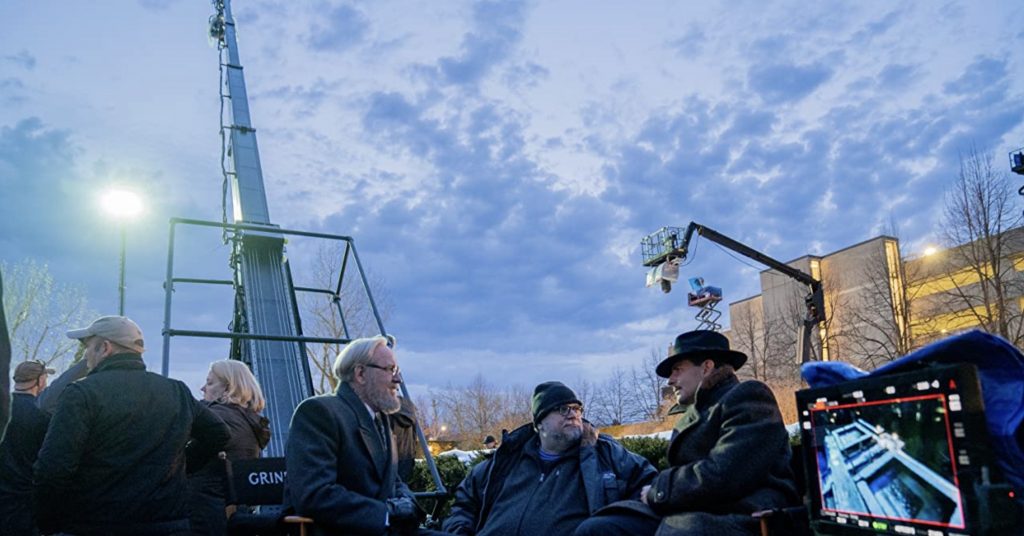
J. Miles Dale, Richard Jenkins, Guillermo del Toro and Bradley Cooper on set, Nightmare Alley (2021)
“I’m from the Old School of ‘Best Idea Wins’.”
AB: Why did you decide to do Nightmare Alley? It’s a pretty heavy piece.
Miles: I think Guillermo decided he wanted to do something with his wife, Kim Morgan. An interesting story about Alley is that Ron Perlman brought him the story 30 years ago when they did Cronos. They went to FOX, but FOX said “No”. Fast forward 30 years and we made Antlers and Shape of Water for Searchlight, and Guillermo started to adapt Nightmare Alley. All of a sudden, FOX said “Ya’ and it was a go.
AB: The ending of that film is terrifying – Why is that? And, what did you and Guillermo discuss about the feel of the movie?
Miles: The scary thing about it is that it could be any of us. It’s a thin layer between that character and you or me, circumstantially, navigating the world with our shortfalls. I think that’s why people related to it. It’s a cautionary tale. It says something about their ‘never being enough’. With Stan (played by Bradley Cooper), it was never enough. He was never going to be satisfied. There is also a bit of an imposter syndrome. Are we up to this? Am I a fake? I think what shocks people is that for Brad’s character, Stanton Carlisle, its almost a relief to be found out.
AB: My wife and I watched together and she realized the ending before me. I don’t know why it took me a few more moments – and, the timing of that reveal is perfect – but when it unfolded I was completely moved. It was true ‘horror’. What was it like on set that day?
Miles: We shot that thing on the first day – and, by the way, it was a weather day. We planned to shoot it a few times but Guillermo and Bradley tried it and it worked. So, that scene was the first take.
AB: He knew he was going to suffer the rest of his life for his sins.
Miles: And, he was fine with it. Almost, happy to be caught.
AB: I haven’t been moved on that level since the end of Abel Ferrara’s Bad Lietuenent. Which, prompts me to ask if you think Harvey Keitel’s character goes to Heaven or hell?
Miles: Hell. But, I’m an agnostic Catholic, so it’s whatever you believe. Although, you can see he sets free the guys at the bus station…
AB: And, he does confess his sins and beg forgiveness to his vision of Jesus; who is the cleaning lady in the church…
Miles: By the way, I understand that when he shoots the radio in the car it’s a real gun, live ammo.
AB: 90s indie filmmaking…
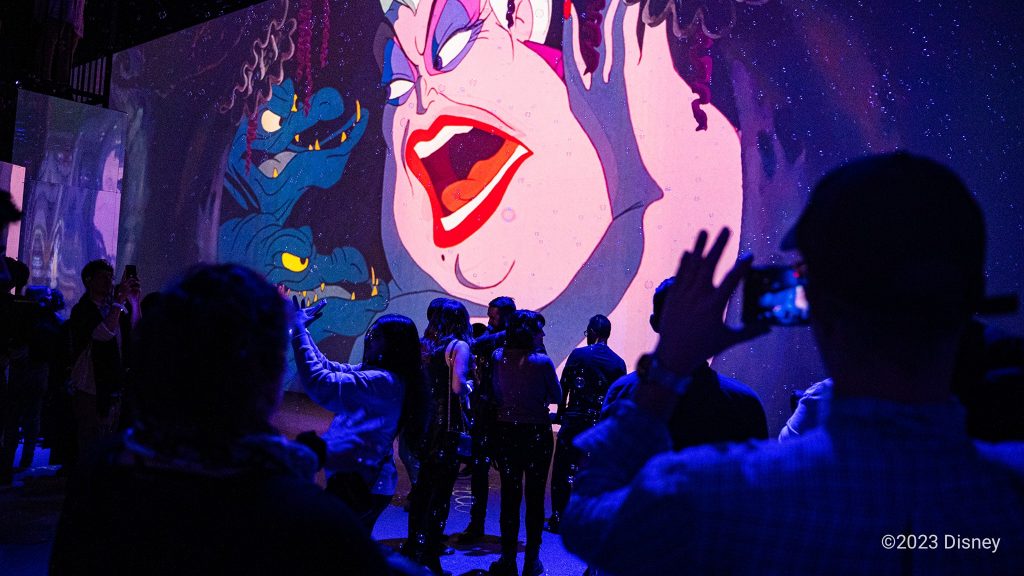
Disney Animation: Immersive Experience courtesy of Lighthouse Immersive
“Lets celebrate 100 Years of Disney creation.”
AB: Why transition from the dark environments of your films into Disney immersive?
Miles: Here’s the thing; Van Gogh was very successful. I liked the newness of the medium, and to be able to bring it to people was exciting to me. With 40 years of film and TV experience I thought, ‘Now what can we do to make this a very different experience?’ We don’t have to put on goggles, we can do it in a communal theater, where we can laugh, sing and dance, and watch our favorite characters together. When we went to Disney they said they usually like to do things themselves but we had some background, so after some conversation they said, ‘Lets do it; let’s celebrate 100 years of Disney creation’.
AB: So, you go to Immersive Van Gogh and later decide to give Disney a call – how does that initial meeting go?
Miles: Corey [Ross, Lighthouse Immersive] called me, and I had seen the show in December and was blown away; And, you start to see opportunities. And, you start thinking. You hear “Immersive” but you don’t really know what is. But, then you see it and it’s very interesting. Before we got to Disney, Corey had done some research and Disney had a couple brands right off the top that connected. We had just done a movie with Disney – Antlers, Nightmare Alley – and had met Alice Taylor, who is in Disney Innovation Lab, so we called Alice and she was like, “Oh, that’s an interesting idea.” She hooked us up with Matthew Deuel, and we got talking, and pretty soon he says, “It’s our 100 year anniversary, and we want to do something.”
AB: Where do you begin regarding content?
Miles: There was a number of ways in; we could do Star Wars, Marvel, Pixar. But they said, specifically, Disney Animation; 100 years from Steamboat Willy, Mickey, to Frozen, etc. So, we had to look at all the movies together to see what works. But, Disney wanted to do it this way because it’s really the cornerstone of their legacy.
AB: Tell me about your favorite Disney movies …
Miles: I loved the classics; Pinnochio, Bambi, and then Dalmations and Jungle Book, which is actually my favorite movie. I sang those songs endlessly. Disney World exposed me to a whole new wave – Lion King, Little Mermaid. Those movies were well know to me but the new movies are due to my children.
AB: And, to what Disney character do you most relate?
Miles: I used to climb a lot of trees, and I am still a little bit curious, so I can’t abandon my man Mowgli at this stage. I first saw Jungle Book when I was seven. Fantasia, for 1940, by the way, was completely mind-blowing. Disney really let his animators go wild with that one.
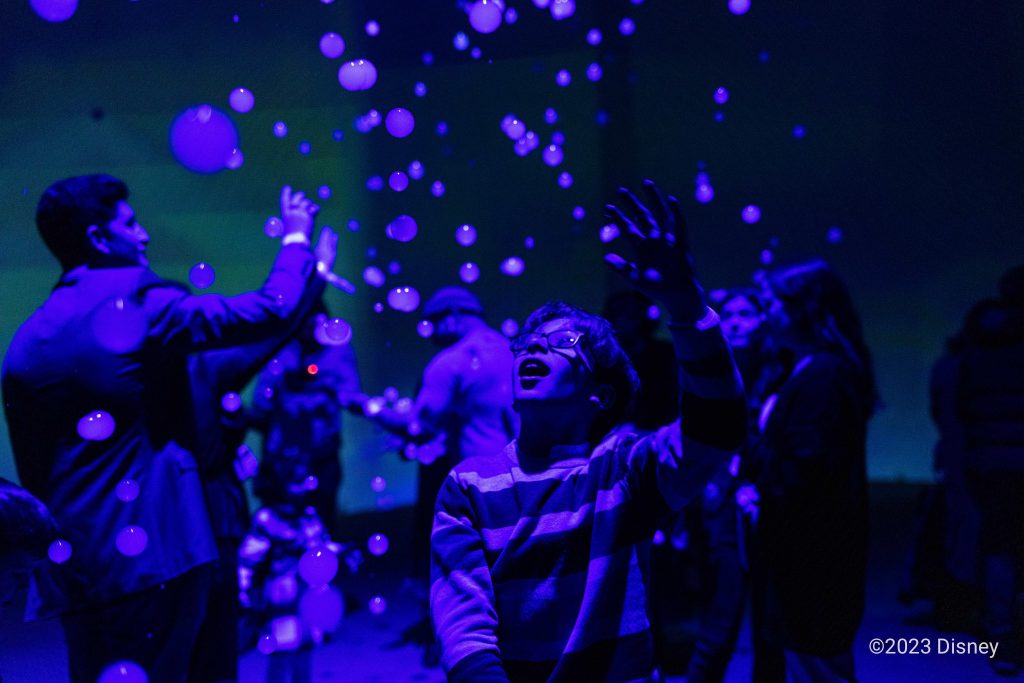
Immersive Experience
“We’re only dipping our toe into this tech but now it’s time to jump into the ocean.”
AB: What was the process of producing an immersive experience on this scale?
Miles: It’s really a team sport because, for one, although I love Disney, I needed Disney experts. Chris Vaughn and his team at Disney Animation Legacy Group let us dive deeply into their archives. We needed many people to help access things. First, there was the educational part; seeing how the multi-plane camera was handled, the groundwork, etc. We were shown the archives frame by frame. Very detailed. I mean, some of the frames still had coffee stains on them. Cocolab worked with us. They create all kinds of multi sensory experiences from the Bank of Mexico to Burning Man. Very creative group. It was all very extensive.
AB: And, how do you position yourself amongst all that talent?
Miles: I’ll call myself the ring leader; Im pulling it all together, guiding all those teams. David Korins – who did design on Broadway and television for Hamilton and the Academy Awards – designed a lot of the lobby exhibits and the pre-show. We just had a very diverse group of people to work with. And, it was interesting and fun to learn along the way. This is a brand new medium so there were really no set guidelines for anyone.
AB: And, what do you hope your audience takes from the experience?
Miles: We want people to leave smarter than they came; to see the history of Disney, how it was made, and to have a lot of fun experiencing the wonder of the final product in 360. The Experience is really entertaining for kids; it speaks to adolescence, they get to watch animation from hand drawn to 3D. It’s really interesting to see the evolution of the company and the animators.
AB: Do you see immersive and film coming closer together in the near future – an immersive full length feature film experience, for example?
Miles: Most definitely. I think one of the next phases of this is original content for immersive experiences. How to make it more interactive. How do we take it to the next level. Is it a thing you run through, a challenge, an escape room; its so wide open, that’s the beauty of it. Technology has allowed us to discover a new medium, with the mapping tech now available. We’re only dipping our toe into this tech but now it’s time to jump into the ocean.
AB: Any life lessons you have come away with from Disney that have served you well over the years?
Miles: You watch a movie and you see how those protagonists are wide eyed until they meet temptation. With Kaa the Snake tempting Mowgli, for example, gullibility is replaced by experience; we will all meet temptations and must face them. The bad guy is sort of gone away but those villains epitomize the challenges in life. It’s good to know when to resist temptation – just do the right thing; the importance of friends and family; accepting people for who they are; how we identify and diversity; but I think Disney was a little bit ahead of the game on a lot of that.
AB: Lessons Bradley’s character had gone without in Nightmare Alley…
Miles: Exactly. These lessons that can be learned are ‘forever lessons’. But, I think the biggest thing is for wishes and dreams; if you follow your dreams and work hard at it, your dreams can, sometimes, come true – that’s the thing that I love the most.
AB: Finally, I hear you have a Creative Deal with Netflix: What does that mean and what are you working on?
Miles: I’ve done my last two tv shows with them – Cabinet of Curiosities and Sex/Life. We’re working on some other stuff. We like them; very filmmaker friendly. This next film is going to be very big for them. Can’t really say what it is but it’s a big movie for Netflix based on a well known piece of work. We’re into casting now and del Toro is writing. So, that’s exciting. It’s going to be a very big spring.

